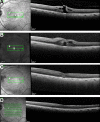Surgical Macular Hole Closure Without a Gas Tamponade
- PMID: 37007721
- PMCID: PMC9976217
- DOI: 10.1177/24741264211018958
Surgical Macular Hole Closure Without a Gas Tamponade
Abstract
Purpose: This work aims to evaluate the outcomes of a series of macular hole (MH) surgical procedures in patients who had pars plana vitrectomy (PPV) with internal limiting membrane (ILM) peel and without gas tamponade.
Methods: Patients from a retina specialty clinic who had MHs were identified for this interventional case series. Patients with small MHs were offered inclusion into the trial. Patients with larger MHs were excluded. They underwent standard 3-port PPV and ILM peel without gas or air to treat small MHs. The main outcomes that we measured were closure of MH and visual results.
Results: Small MHs in 5 patients were managed with PPV and ILM peel alone. The average preoperative hole size at its narrowest width was 227 µm (range, 173-294 µm). Four of 5 patients (80%) had successful hole closure without a gas tamponade and improved vision; 1 patient did not have hole closure and was treated with an in-office gas bubble to close the hole. The average preoperative vision at 3 months was 20/80- (54 Early Treatment Diabetic Retinopathy Study [ETDRS] letters) and improved to 20/30-2 (73 ETDRS letters) in the 4 patients whose MHs were closed with surgery without a gas bubble. This was statistically significant (P = .003). The hole that did not close initially without gas tamponade was the largest in the series.
Conclusions: Patients with small MHs can be successfully treated with a vitrectomy and ILM peel alone without a gas tamponade.
Keywords: intraocular; intraocular gases; macular holes; small-gauge vitrectomy; tamponades.
© The Author(s) 2021.
Conflict of interest statement
The author(s) declared no potential conflicts of interest with respect to the research, authorship, and/or publication of this article.
Figures





References
-
- Kelly NE, Wendel RT. Vitreous surgery for idiopathic macular holes. Results of a pilot study. Arch Ophthalmol. 1991;109(5):654–659. doi:10.1001/archopht.1991.01080050068031 - PubMed
-
- Wendel RT, Patel AC, Kelly NE, Salzano TC, Wells JW, Novack GD. Vitreous surgery for macular holes. Ophthalmology. 1993;100(11):1671-1676. doi:10.1016/s0161-6420(93)31419-3 - PubMed
-
- Eckardt C, Eckardt U, Groos S, Luciano L, Reale E. Removal of the internal limiting membrane in macular holes. clinical and morphological findings [article in German]. Ophthalmologe. 1997;94(8):545–551. doi:10.1007/s003470050156 - PubMed
-
- Brooks H. Macular hole surgery with and without internal limiting membrane peeling. Ophthalmology. 2000;107(10):1939–1948. doi:10.1016/s0161-6420(00)00331-6 - PubMed
-
- Eckardt C, Eckert T, Eckardt UT, Porkert U, Gesser C. Macular hole surgery with air tamponade and optical coherence tomography-based duration of face-down positioning. Retina. 2008;28(8):1087–1096. doi:10.1097/IAE.0b013e318185fb5f - PubMed
LinkOut - more resources
Full Text Sources
Miscellaneous

